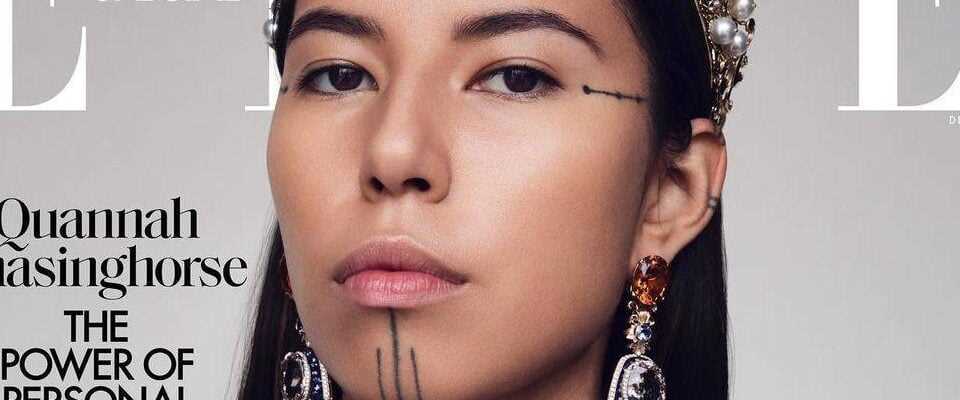Quannah Chasinghorse with her traditional face tattoos, also called Yidįįłtoo, on the cover of the American Elle.
Instagram / quannahchasinghorse
Published
Quannah Chasinghorse is one of the indigenous models who made the breakthrough on the international fashion scene. She wants to use her platform to represent her culture.
The last few years the fashion industry has become more inclusive. Meanwhile, the catwalks do not only belong to spindly white models – always more Models pave their way onto the catwalk and in the fashion magazines, those a place in the Industry long denied stayed. In addition to plus–Size–Models for example too indigenous models like Quannah Chasinghorse.
Activist and model
Before Quannah Chasinghorse became part of the fashion world, she drew attention to the climate crisis as an environmental activist. She still uses her platform to this day. The 19-year-old comes from Alaska, where the effects of global warming, such as the disappearance of permafrost, are particularly noticeable. She also campaigned to stop drilling for oil in Alaska.
The fashion industry also became aware of her through her activist work. After a campaign with Calvin Klein, the international modeling agency IMG Models signed Quannah.
Quannah Chasinghorse is descended from the Hän Gwich’in tribes (from Alaska and Canada) and from the Oglala Lakota (from South Dakota). She has always been passionate about watching fashion shows, but never sees her culture represented in them: “I was obsessed with watching catwalk shows from Dior, Chanel or Prada on television and I always posed for photos,” she says to the US Vogue ». Because of the lack of representation from indigenous models, it was really difficult for her to have the feeling that she even had the potential to become a model.
Indigenous representation in the fashion industry
In the meantime, Quannah Chasinghorse has become a figurehead herself that she would have wished for in her youth. She made her New York Fashion Week debut for the American designer Prabal Gurung:
For designers Gabriela Hearst the Eldershe even dhe show open and close. Hearst’s collection was designed and woven by two Navajo women.
For the show for 100 year anniversary of Gucci Quannah was on the catwalk too.
2021 the model even became to the Met Gala invited. Quannah combined turquoise with her Peter Dundas robe, indigenous jewelry. «The turquoise stands for protection, guidance and love. I felt all of this as I walked the red carpet and the spirit of my ancestors accompanied me.»
Quannear nalso used their platform at the Met Gala to show ihear To make culture visible: «It is truly an empowering feeling to know that my presence brings much-needed visibility to indigenous beauty, fashion, art and our communities», schrieb she to on Instagram.
That is what her face tattoo means
The lines on Quannah Chasinghorses chin are traditional Hän Gwich tattoos, also called yidįįłtoo. Like many indigenous traditions and languages, missionaries banned these traditional face tattoos in the 19th and 20th centuries. “The possibility to bring back the tattoos is a strong thing – you feel empowered because you know that you are continuing a tradition that should actually be wiped out,” the model told US “Vogue”.
“The traditional tattoos aren’t just for looks, they’re not a trend or a fad. I had to be spiritually, mentally and emotionally ready for the big step of bearing these markings in today’s world. The tattoos are traditionally done by hand by a woman, ”she writes on Instagram. With Quannah, it was her own mother who tattooed the lines on her chin and forehead. “Every yidįįłtoo (tattoo) performed in a ceremony represents a rite of passage, becomes part of our history and has a powerful meaning,” says Quannah.
More indigenous faces in the fashion industry
Quannah Chasinghorse isn’t the only indigenous model to hit the international fashion scene. Cherokee Jack also ran on Gabriela Hearst’s show last year. A very emotional moment for him: “I held back tears because I never saw indigenous men at fashion week or in campaigns.”
Cherokee Jack sees himself, wie Quannah, in responsibility, to share his experiences as he did the US- «Vogue» says: «There are so many people who have never met an indigenous person. It is each individual’s privilege and responsibility to be informed, but I am in a position where I can share and relate my own experiences.»
Valentine Alvarez is another indigenous model who made the breakthrough in the international scene and also at Gucci’s 100th anniversary–Anniversary–Show ran:
«Growing up was the fashion very Eurocentric»says Valentine to the US- «Vogue». «I didn’t grow up feeling beautiful. I felt like I could never be a model.»
She adds: «Everyone who was considered the epitome of beauty didn’t look like me – they didn’t have a bridge of their noses like me and they didn’t have brown skin like me.» That is one of the reasons, why representation is so important: «That makes me want to show my face in more places because I want more people who recognize themselves to see me and know that they are beautiful too.»
Are you or is someone you know affected by racism?
GRASSfoundation against Racism and Anti-Semitism
As a member, you become part of the 20-minute community and benefit from great benefits and exclusive competitions every day!
